Astronomy:(19308) 1996 TO66
 Hubble Space Telescope image of 1996 TO66 taken in 2005 | |
| Discovery | |
|---|---|
| Discovered by |
|
| Discovery date | 12 October 1996 |
| Designations | |
| (19308) 1996 TO66 | |
| Minor planet category | |
| Orbital characteristics[2] | |
| Epoch 13 January 2016 (JD 2457400.5) | |
| Uncertainty parameter 3 | |
| Observation arc | 7322 days (20.05 yr) |
| |{{{apsis}}}|helion}} | 48.375 astronomical unit|AU (7.2368 Tm) |
| |{{{apsis}}}|helion}} | 37.939 AU (5.6756 Tm) |
| 43.157 AU (6.4562 Tm) | |
| Eccentricity | 0.12090 |
| Orbital period | 283.52 yr (103,555 d) |
| Mean anomaly | 137.16° |
| Mean motion | 0° 0m 12.515s / day |
| Inclination | 27.4948° |
| Longitude of ascending node | 355.2889° |
| 239.07° | |
| Earth MOID | 37.0117 AU (5.53687 Tm) |
| Jupiter MOID | 33.0091 AU (4.93809 Tm) |
| Physical characteristics | |
| Dimensions | |
| Rotation period | 7.92 h (0.330 d) |
| Sidereal rotation period | 7.92 h[2] |
| Geometric albedo | 0.7 (assumed) |
| Physics | ~43 K |
| Absolute magnitude (H) | 4.5 |
(19308) 1996 TO66 (provisional designation 1996 TO66) is a trans-Neptunian object that was discovered in 1996 by Chadwick Trujillo, David Jewitt and Jane Luu. Until 20000 Varuna was discovered, it was the second-largest known object in the Kuiper belt, after Pluto.
Origin

Based on their common pattern of IR water-ice absorptions, neutral visible spectrum[7] and the clustering of their orbital elements, the other KBOs (24835) 1995 SM55, (55636) 2002 TX300, (120178) 2003 OP32 and (145453) 2005 RR43 all appear to be collisional fragments broken off of the dwarf planet Haumea.
Orbit
The eccentricity of 1996 TO66 varies between ca. 0.110 and 0.125 every 2 million years, with additional variations on the order of ± 0.01 on much shorter time scales. It is in an intermittent 19:11 resonance with Neptune. The resonance breaks every 2 million years when the eccentricity is highest and the orbit is closest to Neptune.[1]
References
- ↑ 1.0 1.1 D. Ragozzine; M. E. Brown (2007-09-04). "Candidate Members and Age Estimate of the Family of Kuiper Belt Object 2003 EL61". The Astronomical Journal 134 (6): 2160–2167. doi:10.1086/522334. Bibcode: 2007AJ....134.2160R.
- ↑ 2.0 2.1 "JPL Small-Body Database Browser: 19308 (1996 TO66)". https://ssd.jpl.nasa.gov/sbdb.cgi?sstr=1996TO66. Retrieved 5 April 2016.
- ↑ Dan Bruton. "Conversion of Absolute Magnitude to Diameter for Minor Planets". Department of Physics & Astronomy (Stephen F. Austin State University). Archived from the original on 23 March 2010. https://web.archive.org/web/20100323180835/http://www.physics.sfasu.edu/astro/asteroids/sizemagnitude.html. Retrieved 2009-12-27.
- ↑ Grundy, W. M. (2004). "Diverse albedos of small trans-neptunian objects". Icarus 176 (1): 184–191. doi:10.1016/j.icarus.2005.01.007. Bibcode: 2005Icar..176..184G.
- ↑ Snodgrass, Carry; Dumas, Hainaut (16 December 2009). "Characterisation of candidate members of (136108) Haumea's family". Astronomy and Astrophysics 511: A72. doi:10.1051/0004-6361/200913031. Bibcode: 2010A&A...511A..72S.
- ↑ Tegler, Stephen C. (2007-02-01). "Kuiper Belt Object Magnitudes and Surface Colors". http://www.physics.nau.edu/~tegler/research/survey.htm. Retrieved 2006-11-07.
- ↑ Pinilla-Alonso, N.; Licandro, J.; Gil-Hutton, R.; Brunetto, R. (June 2007). "The water ice rich surface of (145453) 2005 RR43: a case for a carbon-depleted population of TNOs?". Astronomy and Astrophysics 468 (1): L25. doi:10.1051/0004-6361:20077294. Bibcode: 2007A&A...468L..25P.
External links
- First Rotation Period of a Kuiper Belt Object Measured – ESO, 5 November 1998
- (19308) 1996 TO66 at the JPL Small-Body Database
 |


